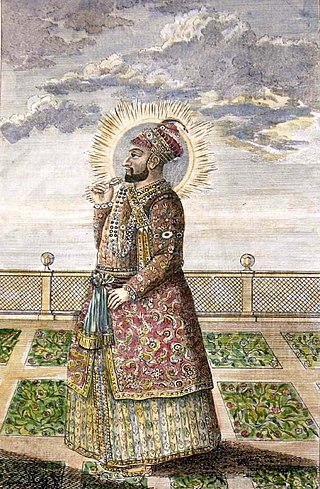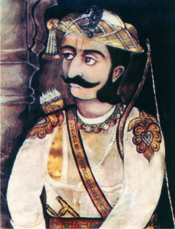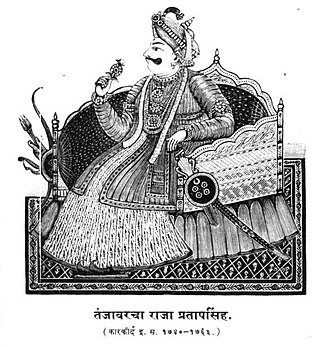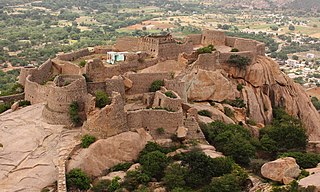
Hyder Ali was the Sultan and de facto ruler of the Kingdom of Mysore in southern India. Born as Hyder Ali, he distinguished himself as a soldier, eventually drawing the attention of Mysore's rulers. Rising to the post of Dalavayi (commander-in-chief) to Krishnaraja Wodeyar II, he came to dominate the titular monarch and the Mysore government. He became the de facto ruler, King of Mysore as Sarvadhikari by 1761. During intermittent conflicts against the East India Company during the First and Second Anglo–Mysore Wars, King Hyder Ali was the military leader.

Madhavrao I was the son of Peshwa Balaji Bajirao and grandson of Peshwa Bajirao I who served as 9th Peshwa of the Maratha Confederacy. During his tenure, the Maratha Confederacy recovered from the losses they suffered during the Third Battle of Panipat, an event known as Maratha Resurrection.

The First Anglo-Mysore War (1767–1769) was a conflict in India between the Sultanate of Mysore and the East India Company. The war was instigated in part by the machinations of Asaf Jah II, the Nizam of Hyderabad, who sought to divert the company's resources from attempts to gain control over the Northern Circars.

The Carnatic Sultanate was a kingdom in South India between about 1690 and 1855, and was under the legal purview of the Nizam of Hyderabad, until their demise. They initially had their capital at Arcot in the present-day Indian state of Tamil Nadu. Their rule is an important period in the history of the Carnatic and Coromandel Coast regions, in which the Mughal Empire gave way to the rising influence of the Maratha Empire, and later the emergence of the British Raj.

Chanda Sahib was a subject of the Carnatic Sultanate between 1749 and 1752. He was the son-in-law of the Nawab of Carnatic Dost Ali Khan, under whom he was a Dewan. An ally of the French, he was initially supported by Joseph François Dupleix during the Carnatic Wars. He annexed the Madurai Nayaks and was declared Nawab, bringing Tanjore and Tinnevelly into the dominions of the Mughal Empire.
Sa'adatullah Khan II a.k.a. Muhammad Sayyid was Nawab of Arcot, who was a younger son of Safdar Ali Khan.

Raghuji I was a Maratha general of the Bhonsle clan who established the Nagpur Kingdom in much of east-central India during the reign of Chhatrapati Shahu I. His successors ruled the kingdom until 1853.

Pratap Singh Bhonsle or Pratapsinha was the Maratha ruler of Thanjavur of the Bhonsle dynasty from 1739 to 1763. His rise to power followed three years of anarchy and civil war and restored the state to its previous greatness. His reign witnessed the Carnatic Wars and the Seven Years' War.
Uchangidurga is a main Holy & Historical village/town in Harapanahalli Taluk of Vijayanagara District in Karnataka, India. It is 29km away from both Harapanahalli and Davanagere, it is located on state highway 47 & it comes under Harapanahalli taluk of Vijayanagara district in Karnataka.

Dhondia Wagh was a military soldier and adventurer in 18th century India. He started his career in the service of Hyder Ali, the ruler of Mysore. During the Third Anglo-Mysore War, he deserted Ali's successor Tipu Sultan, and subsequently raided territories on the Maratha-Mysore border. After the Marathas forced him to retreat, he sought refuge from Tipu and converted to Islam, changing his name to Malik Jahan Khan. After Tipu's death in the Fourth Anglo-Mysore War, he raised a force comprising soldiers from the former Mysore Army, and took control of northern part of the Mysore Kingdom. He styled himself as Ubhaya-Lokadheeshwara. The British East India Company as well as the Maratha Peshwa sent armies to check his rising power. He was ultimately defeated and killed by a British force led by Arthur Wellesley.
The Maratha–Mysore wars were a conflict in the 18th century India between the Maratha Confederacy and the Kingdom of Mysore. Though initial hostilities between the sides started in 1760s, the last battle began in February 1785 and ended in 1787.

The Siege of Trichinopoly was part of an extended series of conflicts between the Nizam of Hyderabad and the Maratha Empire for control of the Carnatic region. On 29 August 1743, after a six-month siege, Murari Rao surrendered, giving Nizam ul Mulk (Nizam) the suzerainty of Trichinopoly. By the end of 1743, the Nizam had regained full control of Deccan. This stopped the Maratha interference in the region and ended their hegemony over the Carnatic. The Nizam resolved the internal conflicts among the regional hereditary nobles (Nawabs) for the seat of governor (Subedar) of Arcot State, and monitored the activities of the British East India company and French East India Company by limiting their access to ports and trading.

Tiruchirappalli is believed to be of great antiquity and has been ruled by the Early Cholas, Mutharaiyars Early Pandyas, Pallavas, Medieval Cholas, Later Cholas, Later Pandyas, Delhi Sultanate, Ma'bar Sultanate, Vijayanagar Empire, Nayak Dynasty, the Carnatic state and the British at different times. The archaeologically important town of Uraiyur which served as the capital of the Early Cholas is a Neighborhood of Tiruchirapalli.

Durgaastamana is a 1982 historical novel by the Kannada novelist and scholar T. R. Subba Rao, popularly known as TaRaSu. As the name indicates, the book charts the downfall of the Nayakas of Chitradurga, a dynasty that ruled there for two centuries. The story follows the epic battle between Madakari Nayaka and Hyder Ali of Mysore in 1779, as the latter lays siege to the fort, and the events and political intrigues leading up to it.

The Gooty Fort, also known as Ravadurg and Gutti Kota, is a ruined fort located on a hill in the Gooty town of Andhra Pradesh, India. The town of Gooty is located in the Ananthapur district of Andhra Pradesh. It is one of the centrally protected monuments of national importance.
Kabbaldurga is a ruined fort located in Ramanagara district, Karnataka. It is at a distance of 75 km from Bangalore. Murari Rao Ghorpade, 18th century Maratha chieftain who controlled Gooty was defeated by Hyder Ali in 1776 AD and kept in Kabbaldurga fort till death. Murari Rao surrendered and sent to this fort along with his family members. During British Raj, convicts were thrown off the cliff of this port, as a punishment. As it is near Bangalore, it is a favourite trekking destination, which is a relatively easy trekking and night trekking is also undertaken by private groups. Old and crumbling buildings on top of the fort represent a prison, garrison, ammunition storage godown and there are small temples of Bheemalilngeshwara and Kabbalamma temple.

Satyabodha Tirtha was an Indian philosopher, scholar, yogi, mystic and saint. He was the 25th pontiff of Uttaradi Math and served the pontificate from March 1744 - 9 March 1783. Satyabodha Tirtha was a great yogi and was honoured by both Hindu and Muslim rulers of his time. Satyabodha Tirtha enjoyed a good fame as a miracle-man. Almost all the princes of the South India used to worship him and were his ardent disciples. Murari Rao of Gooty, Raghoji Bhosale and Fateh Singh Rao Gaekwad, were his great disciples. Satyabodha Tirtha Swamiji's mission of peace has played a prominent role during this time. He earned a reputation as the greatest of Madhva saints of his time for his un-rivaled scholarship, miraculous achievements and dynamism as the pontiff of the Uttaradi Math. So many were his achievements and so well was he liked, admired and respected by people of all castes and creeds, rich and poor, that the Uttaradi Math in Savanur got the name as Satyabodha Math after him. Satyabodha Tirtha is believed to be the incarnation of Markandeya.

Madakasira Fort, also known as Simhagiri, is a hill fort located in the Madakasira town of Sri Sathya Sai district, in Andhra Pradesh, India. The Government of India has designated it as a Monument of National Importance.
When Maratha forces invaded the Carnatic region in southeastern India, Dost Ali Khan, the Nawab of Arcot, took a defensive stance at Damalcherry Pass, located 30 miles north of Ambur. In a disastrous defeat, Maratha General Raghoji I Fateh Singh and Murari Rao outflanked them and struck from the rear, resulting in the defeat and death of Dost Ali and his son Hassan Ali. Bhonsle then captured Arcot and subsequently besieged and took Trichinopoly on May 31, 1741.
Nizam-ul-Mulk established his authority in Karnataka, while Chanda Saheb rose to prominence. Shahu appointed Raghuji Bhonsle and Fateh Singh to collect tribute from Karnataka and protect the Tanjore region against Chanda Saheb. Raghuji and Fateh Singh advanced on Arcot, where Dost Ali Khan fell fighting the Marathas. His son, Safdar Ali, sought refuge in Vellore, and the valuables of the Nawab were sent to Pondicherry.













